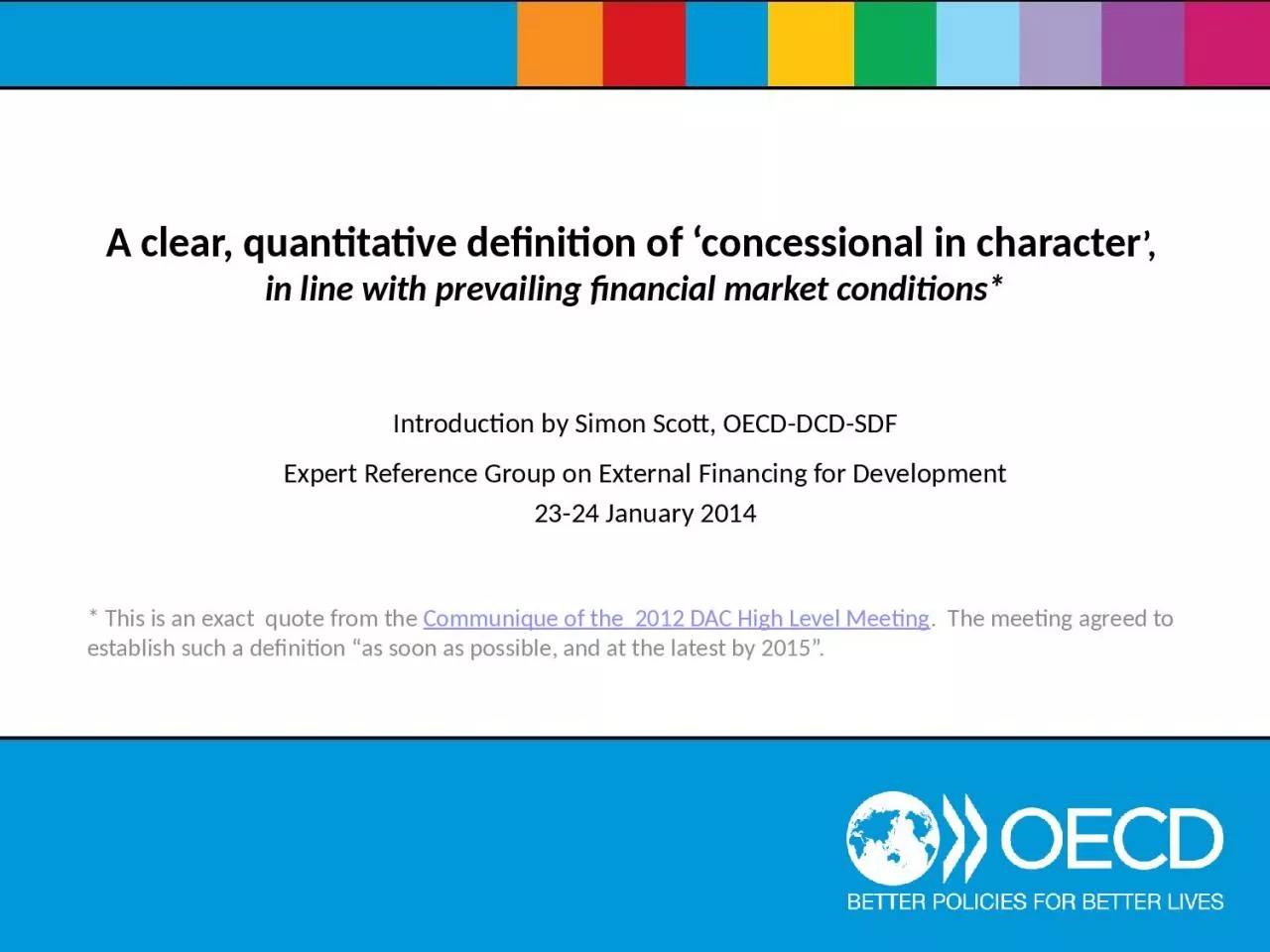

concessional in character in line with prevailing financial market conditions Introduction by Simon Scott OECDDCDSDF Expert Reference Group on External Financing for Development ID: 1026091
Download Presentation The PPT/PDF document "A clear, quantitative definition of" is the property of its rightful owner. Permission is granted to download and print the materials on this web site for personal, non-commercial use only, and to display it on your personal computer provided you do not modify the materials and that you retain all copyright notices contained in the materials. By downloading content from our website, you accept the terms of this agreement.
1. A clear, quantitative definition of ‘concessional in character’, in line with prevailing financial market conditions*Introduction by Simon Scott, OECD-DCD-SDFExpert Reference Group on External Financing for Development23-24 January 2014* This is an exact quote from the Communique of the 2012 DAC High Level Meeting. The meeting agreed to establish such a definition “as soon as possible, and at the latest by 2015”.
2. How is loan concessionality expressed?Long maturity (=grace period+repayment period)Presence of grace period (extended interval to first repayment of principal)Low interest rate
3. How is concessionality measured? A “grant element” calculation measures concessionality, taking account of maturity, grace period, and interest rateSuch calculations need a reference interest rate as a benchmarkThe choice of discount rate is crucial to the result of a grant element calculation – different rates gives different answers to: whether a loan is concessionalhow concessional it is, and whether it is more concessional than another loan
4. Dimensions of choice for discount rate and grant elementFixed, or differentiated?Risk-free, or risk adjusted?Applied as a cut-off (ruling some loans in and some loans out), or as a continuum (counting “concessional elements” of all loans)?
5. Fixed vs. differentiated discount ratesAdvantages of fixed rateLoans at the same terms always have the same grant element, regardless of donor, recipient, currency and yearConsistent with current system (10% fixed rate) and recent IMF decision (5%)Advantages of differentiated rateCan reflect cost of borrowing and risk of lendingConsistent with system used for export credits and tied aid (OECD Differentiated Discount Rates) and with previous IMF system (based on CIRRs)
6. Risk-free vs. risk-adjusted discount rates(both assume differentiated rates)Advantages of risk-freeSimple and well-knownAvoids controversy over creditworthiness of borrowerAvoids difficulties of accounting for effects of guarantees, insurance, seniority, political risks etc.Allows reporting of debt relief if loan forgivenAdvantages of risk-adjustedDraft methodology already proposed by Canada, France, Germany and SpainMore accurately reflects likely final cost of loanAvoids need for reporting on debt relief, since risk of this happening already included in valuation of grant element
7. Cut-off vs. continuumAdvantages of cut-offAllows reporting of actual loan flows, which isThe current systemWhat the recipient actually receives and pays in cashThe same basis as used for other financing, thus allowing summation of all official and private flowsAdvantages of continuumAllows reporting of all concessional elements in loans, whichMore accurately valorises effortAvoids “sudden death” exclusion of loans just below the thresholdEncourages optimal use of interest rate subsidies
8. Trends in thinking10% is seen as not reflecting financial conditionsMovement towards differentiated, risk- adjusted rates and counting all grant equivalentsThis is a fairer measure of effort and “burden-sharing”Could dispose of objections to counting debt reliefBut no longer a flow measurement, so can’t be added to other official and private flowsUN 0.7% resolution based on “actual disbursements”
9. SummaryQuantifying concessionality requires a reference (discount) rateA fixed rate provides more consistent resultsBut a differentiated rate better values effortMeasuring actual flows requires a cut-off; measuring concessional elements does not require a cut-offIf the discount rate values the risk of default, then actual default should not require a new entryMost favour “effort measurement” of loans, which incentivises efficient use of concessional resourcesThis breaks with the flow basis of data, and may have implications for other instruments, e.g. equity and guarantees